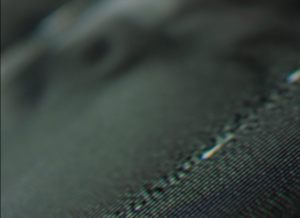Plastic and Rust: Memory Through the Lens of Early Videotape Psychotherapy Archives
Carmine Grimaldi is a 2023-24 RPW Faculty Theme Fellow. This year’s cohort explores the theme of “The Place of Memory.”
The Introduction of Videotape

My research focuses on the early social history of videotape, when the electronic image crept into and profoundly reshaped the institutions and daily experiences of postwar America. In contrast to film, the new medium transformed the television screen into a responsive participant in everyday life, able to replay events at the time and place they occurred.
This might seem relatively mundane today, but at the time this possibility appeared to many as revolutionary: this wasn’t a technology that simply conveyed information or represented reality; to many, this promised the possibility of transforming behavior through cybernetic feedback, opening new possibilities of thinking and feeling, and even creating new identities and senses of self. In psychiatric clinics, classrooms, courtrooms, and many other contexts, video seemed – for about a decade – to offer vast and exhilarating possibilities.
An Early Pioneer of Videotape Psychotherapy
In the past, I’ve written about this in my role as a historian, but during my year at the Robert Penn Warren Center for Humanities, I’ll be exploring the subject through the production of a film that is built from a peculiar archive that has recently come into my possession. Last summer, the family of one of the early pioneers of videotape psychotherapy bequeathed to me his entire collection of video therapy sessions, comprising thousands of hours. While there are many written accounts of this movement, this collection offers a unique opportunity to observe, explore, and experiment with the actual moments in which people first confronted a new technology, first began to ponder the boundaries of their psyche in an electronically mediated environment.
Central to this institute for videotape therapy was the question of memory, and particularly, how technologies could be applied to radically reshape it. The technology could record, preserve and replay the patients to themselves, deliberately reframing and staging the subject for later reference. But there was also a subtractive element to his work, as this psychiatrist was equally invested in electroconvulsive therapy (ECT), which he would at times apply to literally erase memories.
In this way, this record is also a record of an attempt to electrify memory and the self: on the one hand, the pulse of electricity could preserve patients’ actions and thoughts on magnetic tape, serving as a form of virtual and externalized memory; on the other hand, the physical convulsions of electricity through their bodies could undo them, potentially erasing memories and reconfiguring their sense of self. Indeed, the boundary between the screen and the body could be blurry: the mind could be treated much like a magnetic tape, erasing and rerecording it with ease.
Having accepted the archive, I have been building a digitization lab and preservation center, which serves as the basis for my film. In striking detail, the doctor recorded nearly every session and treatment he had conducted over the years: We see rebellious teens, alcoholics, housewives, holocaust survivors, and those called psychotic all presented with the idea that they could be reborn, to electrically obliterate their trauma and habits, and become as malleable as the iron oxide that preserves these encounters. We see, in other words, a beginning—rendered in granular detail—of our present and future, in which we are increasingly imbricated with the ubiquitous electrical infrastructure of the self.
Using Film to Convey Experiences
As a filmmaker, I have been trying to develop a style to best convey these experiences, a form that both preserves the anonymity of patients while also conveying their experiences and stories. In keeping with the technologies that both transformed and preserved these histories, the film embraces and appropriates the very forms that enmeshed these bodies and minds, forms poised at the fulcrum between an analog past and a digital future. Stylistically, I draw inspiration both from work contemporaneous to the psychiatric experiments—such as the televisual sculptures of Name June Paik, the video processing of the Vasulkas, and the incisive multi-screen montages of Jean-Luc Godard’s Numéro Deux—as well as more recent works that embrace the slippage of past, present, and future, such as Jeremy Shaw’s Quantification Trilogy and Luis López Carrasco’s The Year of Discovery.
Not unlike the patients, the film itself undergoes radical transformation, moving from the aesthetic of analog video—mixing and manipulating the material through video synthesizers and the texture of the televisual image—up to their future afterlives in the digital archive, where these patients now inhabit a three-dimensional realm of photogrammetry and gaussian splats and avatars processed and re-processed in the decades-long transition from flesh to tape to computers. Through these audiovisual techniques, I seek to show how we can recuperate experiences that must otherwise remain hidden.
 Carmine Grimaldi is an Assistant Professor in the Department of Cinema and Media Arts, where he teaches filmmaking. He received his PhD in history at the University of Chicago, and trained as a filmmaker at Harvard’s Sensory Ethnography Lab. His films have screened at festivals such as Visions du Reel, True/False, The Museum of the Moving Image, Camden, RIDM, Sheffield Doc/Fest, and DokuFest, where he was awarded the prize for best short film, and in 2017 was named one of the 25 New Faces of Independent Film by Filmmaker Magazine. His writings on film and media have appeared in Representations, LARB, Millennium Film Journal,Mubi Notebook, and The Atlantic.
Carmine Grimaldi is an Assistant Professor in the Department of Cinema and Media Arts, where he teaches filmmaking. He received his PhD in history at the University of Chicago, and trained as a filmmaker at Harvard’s Sensory Ethnography Lab. His films have screened at festivals such as Visions du Reel, True/False, The Museum of the Moving Image, Camden, RIDM, Sheffield Doc/Fest, and DokuFest, where he was awarded the prize for best short film, and in 2017 was named one of the 25 New Faces of Independent Film by Filmmaker Magazine. His writings on film and media have appeared in Representations, LARB, Millennium Film Journal,Mubi Notebook, and The Atlantic.